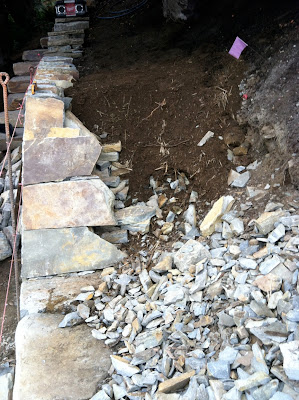I did a site drawing for our client (see earlier blog post October 3, 2011)proposing new walls, stairs, a gothic dry stone arch, and pathways. I love to draw, but not super tight….
 |
| We took 25 yards of soil out from this area to bring it to the proper grade before we we began our wall. |
Our client wanted this wall to stand out distinctly from the other work we had done, yet tie in with the same language. To do this we used the same Montana Slate materials, from a different quarry there, as well as the same stone from the dry stone retaining wall along the driveway. Functionally I needed to build stairs down from the deck to a path, which evolved to a dry stone arch hidden in the trees, to another set of stairs-which became cantilevered to this wall.
I had found a large beautiful piece of granite(at Marenakos in Preston Washington) for the right wall end by the stop sign. It was 9′ long by 16″ tall rising to 48″. Our client loved this idea in the entirety and we began some 12 months ago.
So the wild thing about this project was the staging of 80-90 tons of stone in this space, plus room for machinery, building, access to the mailbox, and keeping the city of Bellingham happy with our water runoff from the site into storm water drains. We got to know the city people quite well working here.
I decided to build a set of stairs down from the deck first to gain access to the slope safely every day. From there we located the arch site in the trees, established a path to the arch, and built the 2′ tall dry stone retaining wall along the path which connects the arch to the stairs. To figure out where the stairs where the cantilevered stairs were going to start, I had to set the large piece of granite and establish the line of my dry stone retaining wall with it’s base course.
So once that line was established we started with the cantilevered stairs and the retaining wall. I knew we needed to get a lot of big material up on the slope by hand, and with machinery, for the arch so we started building the cantilevered stairs up to the arch.
*Side note here…
This is the medium long version of this whole scope of work for this front area by the way….. Which lead up to the final angled/wedge dry stone retaining wall.
After we had built all those details over some period of time, we could finally begin our wall. We needed the cantilevered stairs, and dry stone retaining wall in to function as our wall end on the left.
So we followed our rules……Each stone in these structures has these rules applied, and then with the angled/wedge wall with get to apply the exceptions!
It begins like all dry stone walls built to DSWA standards…
1)Length in for all stones
2)One stone over two, and two stones on one
3)Largest stones go one the bottom of the wall
4)Stones are laid level and solidly
5)Build to the string line, and heart well!
 |
| So we started with 5-6 pallets of 2-3″ thick Montana Slate. We set up our wooden bankers to begin squaring up the stones, and sorting for the build. |
Before we could start building this I had to decide what angle we were going to lay the stone to. I didn’t want it to look like it was slipping, or that it was laid casually. We decided a 60 degree angle looked the best and committed to it for 50′ long by 4′ tall….
You can’t ‘see the forest for the trees’ when you start a wall and this is really when everything seems off.
 |
| And then BAM! It finally snaps together once a pattern language is established! |
 |
| From the side you can see the technique… |
 |
| Another beautiful detail about these walls is the top course. It creates a very beautiful line… |
So here we are almost done…. silt fence still up, bankers have moved with us down the wall, patterns mostly revealed, seasons changing…
 |
| So here is how we end this wall. I had the granite stone on top for about 12 months. It is about 30″ long into the wall. |
 |
| The view from the deck above the wall. |







